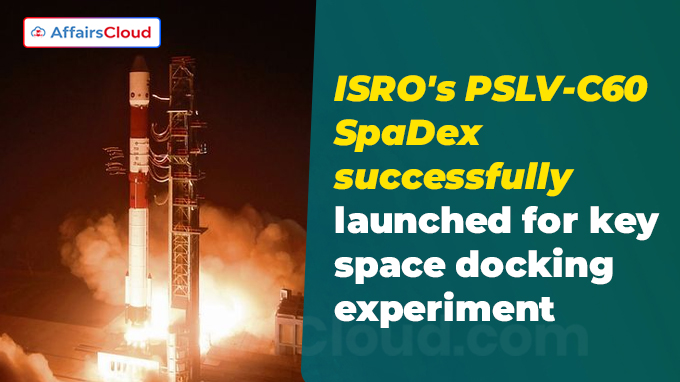 On December 30, 2024, the Indian Space Research Organisation (ISRO) successfully launched the Polar Satellite Launch Vehicle (PSLV)-C60 rocket from the Satish Dhawan Space Centre (SDSC), Sriharikota, Andhra Pradesh (AP). The mission, named Space Docking Experiment (SpaDeX), aims to demonstrate the ability to dock 2 small spacecraft, SDX01 and SDX02, in space.
On December 30, 2024, the Indian Space Research Organisation (ISRO) successfully launched the Polar Satellite Launch Vehicle (PSLV)-C60 rocket from the Satish Dhawan Space Centre (SDSC), Sriharikota, Andhra Pradesh (AP). The mission, named Space Docking Experiment (SpaDeX), aims to demonstrate the ability to dock 2 small spacecraft, SDX01 and SDX02, in space.
- The success of this mission will make India the 4th country in the world, with only space docking technology after Russia (the former USSR), the United States of America (USA) and China.
- The PSLV-C60 mission was ISRO’s 99th launch and will undergo various operations leading up to the final docking by January 7, 2025.
- PSLV rocket becomes the 1st vehicle to be integrated up to the 4th stage at the PSLV Integration Facility (PIF) established at the SDSC.
Key Objectives of the Mission:
The SpaDeX mission is designed to test and demonstrate various advanced space technologies, including rendezvous, docking, and undocking capabilities.
- The mission has 2 primary objectives:
i.Spacecraft Docking and Undocking: The primary goal is to successfully dock two spacecraft in space – SDX01 (the Chaser) and SDX02 (the Target). The process will involve controlled rendezvous, bringing the spacecraft from a distance of 20 kilometer (km) to just 3 meters (ms) before docking.
- The docking will be conducted using precision-controlled maneuvers coordinated by ISRO’s ISTRAC (ISRO Telemetry, Tracking and Command Network) in Bengaluru (Karnataka).
ii.Demonstrating Power Transfer: After docking, the spacecraft will transfer power between each other and then undock to continue their individual operations that will continue upto 2 years.
Mission Details:
i.The PSLV-C60 rocket is 44.5 ms tall which was launched with a total of 24 payloads. This includes 14 payloads from ISRO centers and 10 payloads from non-government entities, including startups and academic institutions through the Indian National Space Promotion and Authorization Center (IN-SPACe).
ii.Orbit and Payload: The PSLV-C60 rocket placed the SpaDeX spacecraft into a 475 km Low Earth Circular Orbit (LEO) with a 55° inclination, each spacecraft weighs 220 kilograms (kgs) will work together to demonstrate the docking technology in space.
- The SpaDeX spacecraft were designed and developed by the U R Rao Satellite Centre (URSC), Bengaluru (Karnataka) with support from other key ISRO centres.
iii.Spacecraft Specifications: The mission features two small spacecraft:
- SDX01 (Chaser): This spacecraft will approach SDX02 for the docking maneuver.
- SDX02 (Target): This spacecraft will serve as the stationary target for the docking process.
iv.Rendezvous and Docking Process:The docking procedure will begin with the Chaser (SDX01) gradually reducing the distance between itself and the Target (SDX02). The distance will be progressively decreased in the following steps:
- Far Rendezvous: The spacecraft begin at a distance of 20 km.
- Controlled Approach: The Chaser will close the gap with steps of 5 km, 1.5 km, 500 meters, 225 meters, 15 meters, and finally 3 meters, before docking occurs in a precision-controlled manner managed by ISRO’s ISTRAC.
iv.Satellite Assembly and Integration:The Assembly, Integration, and Testing (AIT) of the spacecraft was conducted at ATL’s new state-of-the-art facility in Karnataka Industrial Areas Development Board (KIADB) Aerospace Park, Bengaluru (Karnataka).
- The 10,000 square metre facility can integrate up to 4 large satellites simultaneously and supports advanced technologies for spacecraft manufacturing and integration.
v.After the docking process, both spacecraft will undock and separate, marking the completion of one of the mission’s secondary objectives.
Secondary Objectives:
i.In-Space Electric Power Transfer: The mission where spacecraft need to share energy resources, such as in satellite servicing or space station maintenance.
ii.Composite Spacecraft Control: Managing and coordinating multiple spacecraft in orbit for future interplanetary missions and satellite constellations.
iii.Payload Operations After Separation: Once undocked, both spacecraft will continue their operations, testing the functionality and performance of their payloads.
Note:
Bharatiya Antariksh Station (BAS): The development of docking technologies will be crucial for the creation of a space station, similar to the International Space Station (ISS), in the future.
Mission’s Technological Innovations:
- Differential GNSS-based Satellite Positioning System (SPS): This system provides precise position, navigation, and timing (PNT) solutions for both spacecraft, ensuring accurate control during the docking process.
- Inter-Satellite Communication Link (ISL): This allows for real-time communication and state monitoring between the two spacecraft during the docking procedure.
- GNSS-based Relative Orbit Determination and Propagation (RODP): This processor accurately determines the position and velocity of the spacecraft, essential for precise rendezvous and docking.
About Polar Satellite Launch Vehicle (PSLV):
PSLV is a 3rd-generation launch vehicle, termed as the ‘Workhorse of Indian Space ISRO‘.The 1st successful launch of PSLV took place in October 1994.
Four stages of PSLV:
i.First Stage (PS1):Uses a solid rocket motor (S139).
- Augmented with 6 solid strap-on boosters.
- Provides the initial thrust to lift the rocket (1,750 kg).
ii.Second Stage (PS2):Uses an Earth-storable liquid engine (Vikas engine).
- Liquid engines are efficient and use less fuel compared to solids.
iii.Third Stage (PS3):A solid rocket motor.
- Provides additional thrust after the rocket has passed through the atmosphere.
iv.Fourth Stage (PS4):Uses two Earth-storable liquid engines.
- Responsible for placing the payloads into their final orbit.
- Can be turned on multiple times to release multiple payloads (e.g., PSLV-C43 mission had 31 satellites released in stages).
Variants of PSLV:
- PSLV-G: Has strap-on boosters for extra thrust.
- PSLV-CA: No strap-on boosters.
- PSLV-XL: Similar to PSLV-G but with larger strap-on boosters.
Payload Capacity:
- 1750 kg to Sun-synchronous Polar Orbits (SSO) at an altitude of 600 km.
- 1425 kg to Geosynchronous or Geostationary Orbits (GTO).




